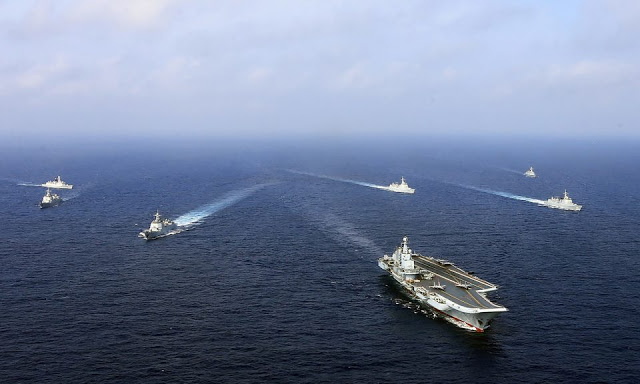China ship fleet expansion has continued at a rapid rate, overtaking Japan to place it number two position after Greece.
Greece is still by some way the largest shipowning country, but the gap is closing.
China fleet constitute numerous giant ore
carriers, tankers and containerships scheduled for delivery to Chinese
owners in the months and years.
carriers, tankers and containerships scheduled for delivery to Chinese
owners in the months and years.
Strong and accelerating growth in the
China-owned merchant ship fleet has unfolded says Richard Scott, md,
Bulk Shipping Analysis and associate, China Centre (Maritime), Solent
University.
China-owned merchant ship fleet has unfolded says Richard Scott, md,
Bulk Shipping Analysis and associate, China Centre (Maritime), Solent
University.
In 2017 an increase exceeding 9% was seen
in the Chinese fleet says Scott and signs suggest this year’s annual
rise could be similar.
in the Chinese fleet says Scott and signs suggest this year’s annual
rise could be similar.
“The extensive orderbook for new vessels
due to be delivered through the next two to three years will add
substantial tonnage, but other less predictable influences also will
determine fleet growth,” said Scott.
due to be delivered through the next two to three years will add
substantial tonnage, but other less predictable influences also will
determine fleet growth,” said Scott.
He said, many new ships will be employed in long-haul international trades where China is the cargo importer or exporter.
For containerships, cargoes both to and
from China are likely to provide employment while, for bulk tonnage in
the biggest size categories, import trades will be most prominent.
from China are likely to provide employment while, for bulk tonnage in
the biggest size categories, import trades will be most prominent.
Amid vast quantities of manufactured
goods and bulk commodities moving, potential for further participation
of China-owned ships is clearly visible but, on some trade routes, other
nationalities’ ships may be displaced.
goods and bulk commodities moving, potential for further participation
of China-owned ships is clearly visible but, on some trade routes, other
nationalities’ ships may be displaced.
Scott’s analysis reveals that in the past
three years and eight months, the China-owned fleet has expanded by
over one-third, a higher percentage increase than seen in the
Greek-owned fleet and much higher than Japan’s minimal
growth.
three years and eight months, the China-owned fleet has expanded by
over one-third, a higher percentage increase than seen in the
Greek-owned fleet and much higher than Japan’s minimal
growth.
Calling on Clarksons Research, Scott
noted, the China-owned fleet recorded growth rates of 6.5% in 2015, 7.5%
in 2016 and 9.4% in 2017, before adding 7.1% in the January-August 2018
period.
noted, the China-owned fleet recorded growth rates of 6.5% in 2015, 7.5%
in 2016 and 9.4% in 2017, before adding 7.1% in the January-August 2018
period.
While the Greek fleet totaled 222m gt,
China’s fleet comprised 7,744 ships of 170m gt at the end of August,
above Japan’s 167.6m gt. China’s fleet has expanded 34% since the end of
2014, compared with a 23% growth for Greece and
just 2% for Japan.
China’s fleet comprised 7,744 ships of 170m gt at the end of August,
above Japan’s 167.6m gt. China’s fleet has expanded 34% since the end of
2014, compared with a 23% growth for Greece and
just 2% for Japan.
At the end of last year, orders at
shipbuilding yards for new vessels to be delivered to China-based
shipowners stood at 25.5m gt total, according to Clarksons, equivalent
to almost 17% of the existing China-owned fleet as calculated
then.
shipbuilding yards for new vessels to be delivered to China-based
shipowners stood at 25.5m gt total, according to Clarksons, equivalent
to almost 17% of the existing China-owned fleet as calculated
then.
Within this orderbook a large proportion
was scheduled for delivery in 2018, and a striking feature was the
numerous orders for the biggest bulk carriers, tankers and
containerships.
was scheduled for delivery in 2018, and a striking feature was the
numerous orders for the biggest bulk carriers, tankers and
containerships.
Newly constructed capacity is the most visible and transparent growth element in the China-owned fleet.
Other influences determining the outcome
are secondhand vessel purchases on the international market, sales of
vessels to that market and existing tonnage sold to shipbreakers in
China or other countries within the global ship
recycling market.
are secondhand vessel purchases on the international market, sales of
vessels to that market and existing tonnage sold to shipbreakers in
China or other countries within the global ship
recycling market.
These transactions are usually more
difficult to track and monitor comprehensively, and therefore overall
estimates rely to some extent on guesswork.
difficult to track and monitor comprehensively, and therefore overall
estimates rely to some extent on guesswork.
And much of the Chinese growth has come
in the s&p market, with Greeks among the main seller to Chinese
interests. This year alone over 20 vessels of 1m gt have left Greek hand
for Chinese.
in the s&p market, with Greeks among the main seller to Chinese
interests. This year alone over 20 vessels of 1m gt have left Greek hand
for Chinese.





